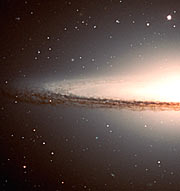Press Release
Fine Shades of a Sombrero
A New Look at an Unusual Galaxy
23 February 2000
In addition to their scientific value, many of the exposures now being obtained by visiting astronomers to ESO's Very Large Telescope (VLT) are also very beautiful. This is certainly true for this new image of the famous early-type spiral galaxy Messier 104, widely known as the "Sombrero" (the Mexican hat) because of its particular shape.
The colour image was made by a combination of three CCD images from the FORS1 multi-mode instrument on VLT ANTU, recently obtained by Peter Barthel from the Kapteyn Institute (Groningen, The Netherlands) during an observing run at the Paranal Observatory. He and Mark Neeser, also from the Kapteyn Institute, produced the composite images.
The galaxy fits perfectly into the 6.8 x 6.8 arcmin 2 field-of-view of the FORS1 camera. A great amount of fine detail is revealed, from the structures in the pronounced dust band in the equatorial plane, to many faint background galaxies that shine through the outer regions.
The "Sombrero" is located in the constellation Virgo (the Virgin), at a distance of about 50 million light-years. The overall "sharpness" of this colour image corresponds to about 0.7 arcsec which translates into a resolution of about 170 light-years at that distance.
About Messier 104
Messier 104 is the 104th object in the famous catalogue of nebulae by French astronomer Charles Messier (1730 - 1817). It was not included in the first two editions (with 45 objects in 1774; 103 in 1781), but Messier soon thereafter added it by hand in his personal copy as a "very faint nebula". The recession velocity, about 1000 km/sec, was first measured by American astronomer Vesto M. Slipher at the Lowell Observatory in 1912; he was also the first to detect the galaxy's rotation.
This galaxy is notable for its dominant nuclear bulge, composed primarily of mature stars, and its nearly edge-on disk composed of stars, gas, and intricately structured dust. The complexity of this dust, and the high resolution of this image, is most apparent directly in front of the bright nucleus, but is also very evident as dark absorbing lanes throughout the disk. A significant fraction of the galaxy disk is even visible on the far side of the source, despite its massive bulge, c.f. ESO Press Photo eso0007c.
A large number of small and slightly diffuse sources can be seen as a swarm in the halo of Messier 104. Most of these are globular clusters, similar to those found in our own Galaxy.
Measurements reveal a steep increase in the mass-to-light ratio and increasing stellar speeds near the nucleus of Messier 104 . This is indicative of the presence of a massive black hole at the centre, estimated at about 10 9 solar masses.
The radio properties of Messier 104 are unusual for a spiral galaxy -- it has a variable core. The optical spectrum of the central region displays emission lines from hot gas (of the "LINER" type -- Low Ionisation Nuclear Emission line Region). This points to Messier 104 harbouring a weak Active Galactic Nucleus (AGN) . Although more commonly known from the much more luminous and distant quasars and powerful radio galaxies, the weak AGN in this galaxy lies at the opposite extreme: the most likely explanation being a central black hole accreting circumnuclear matter at a slow pace.
About the Release
| Release No.: | eso0007 |
| Legacy ID: | Photo 07a-c/00 |
| Name: | M 104, Messier 104, Sombrero Galaxy |
| Type: | Local Universe : Galaxy : Type : Spiral Local Universe : Galaxy : Activity : AGN |
| Facility: | Very Large Telescope |
| Instruments: | FORS1 |



